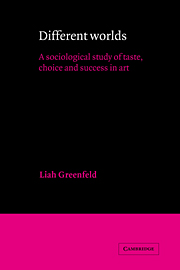Book contents
- Frontmatter
- Contents
- Introduction
- 1 Historical background
- 2 The population of painters and the split into subsystems
- 3 Patterns of success
- 4 The “gatekeepers” – critics
- 5 The “gatekeepers” – curators
- 6 The “gatekeepers” – gallery owners
- 7 The artists – attitudes of Conceptualists and Lyrical Abstractionists
- 8 The artists – attitudes of figurative painters
- 9 The publics
- 10 Conclusion
- Appendices
- Notes
- Index
- Titles in the series
8 - The artists – attitudes of figurative painters
Published online by Cambridge University Press: 16 September 2009
- Frontmatter
- Contents
- Introduction
- 1 Historical background
- 2 The population of painters and the split into subsystems
- 3 Patterns of success
- 4 The “gatekeepers” – critics
- 5 The “gatekeepers” – curators
- 6 The “gatekeepers” – gallery owners
- 7 The artists – attitudes of Conceptualists and Lyrical Abstractionists
- 8 The artists – attitudes of figurative painters
- 9 The publics
- 10 Conclusion
- Appendices
- Notes
- Index
- Titles in the series
Summary
Painters affiliated with the private market provide a fascinating comparison to the artists promoted by the museums.
The fact that immediately attracts the attention of a sociologist is that the structures of the two groups are very different. As the previous chapter has shown Conceptualists (and other Abstract artists) can be defined as an ideological group in Shils' terms despite the absolute normative anarchy in the framework of which they act. In contrast, the visual characteristics of all the Figurative styles presuppose a clear and consistent system of values. (See pp. 9–12; 14–15; 18; 32; 38.) The interviewed artists in this group had no difficulty in formulating their professional ideology in an intelligible way. Yet, they do not constitute a cohesive group which is aware of the importance of its solidarity and cultivates it with the help of certain symbols forming a uniform artistic platform. The borders of this group are not defined and the network of communication of figurative painters is sparse – if it is at all possible to speak about a network of communication common to these artists. Each one of the artists who were interviewed is linked by ties of friendship to different people, known (among his colleagues) to him alone and important for him only – people of different professions, who are connected to art solely by these personal ties. These figurative artists also found it difficult to make a list of twenty painters whose talent and contribution to Israeli art they considered significant.
- Type
- Chapter
- Information
- Different WorldsA Sociological Study of Taste, Choice and Success in Art, pp. 136 - 145Publisher: Cambridge University PressPrint publication year: 1989



